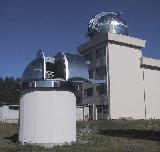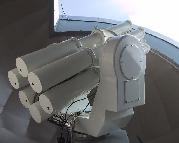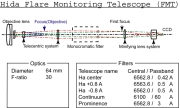The Flare Monitoring Telescope (FMT)
|
About the FMT
|
|
The FMT was constructed in 1992 to investigate the long-term variation
of solar activity and explosive events.
It has been part of the international coordinated observations program (STEP) since 1991.
In March 2010, it was moved from Hida to Ica University in Peru as part of CHAIN-project.
The FMT consists of 6
small telescopes, five of which observe the sun at different
wavelengths or in different modes. The remaining one is equipped with
a guider for accurate tracking of the sun.
FMT observations of the sun at different wavelengths or in different modes
enables us to study how solar activity affects human
activities in space or on The Earth. Such studies enable
improved radio communication operations, electronic
transmissions on The Earth, and experiments in space.
|

The dome of the FMT. Another dome seen backside of the FMT is for the
60cm refractor telescope.
|

The six telescopes in the dome.
|
The images were obtained every two seconds and recorded with
time-lapsed video tapes from 1992 to May 2006.
From September 1996 to May 2006, we had also
been using a digital data recording system with the A/D converter.
Digital images from this system were recorded every minute.
Moreover, in May 2006, we introduced the new digital CCD camera system,
so that pixel resolutions and digital bit depths were improved and
the exposure-time was reduced.
Normally, this new system has obtained one series of digital images every 20 seconds.
|
|
Examples of the data.
|
You can find a "FMT Event-List" which lists all events found using the FMT
images.
|
Please enjoy movies of flares, filament/promience eruptions, surges etc.
Access to current solar images obtained by the FMT.
(After completion of infrastructures at Ica University, this service will be started again.)
You can freely download all FMT raw data in PGM-format or Raw-data format.
|
|
The performance of the telescope system.
|
|
| Apature | 64mm |

The optical system of the telescope. The optical system is common to all the six telescopes. You can find the PDF version here.
|
| Manufactured by | Nishimura Co. Ltd. |
| Focal length | 1920 mm |
| F/ratio | 30 |
| Minifying lens system | Minolta (Now:Conica-Minolta) Co. Ltd. | |
|
| ND Filter | Kenko Co. Ltd. |
R64/N8(Reduction factor: 1/8) |
| Monochromatic filters | Ha center Tele. | 6562.8/0.42 A |
| Ha -0.8 A Tele. | 6562.0/0.5 A |
| Ha +0.8 A Tele. | 6563.6/0.5 A |
| Continuum Tele. | 6100/60 A |
| Prominence Mode Tele. | 6562.8/3 A |
|
Mainly manufactured by Day-Star Co. Ltd. (Central wavelength / FWHM) |
|
|
[After 2006 May]
|
|
|
|
CCD
|
Takenaka System Co.LTD/ Digital Full Frame Shutter Camera
|
FC1500CL (CamLink)
|
|
|
Time Resolution
|
every 20 seconds (changeable)
|
|
|
Bit Depth
|
10 bits
|
|
|
Pixel Number
|
1392x1040
|
[Before 2006 May]
|
|
|
| CCD | Sony Video CCD | AVC-D7 |
| Videos | Panasonic Co. Ltd. | Time-Lapsed Videos (AG-6570A) |
| | Every 2 seconds |
| Digital Form Recorder | PHOTRON Co. Ltd. | AD-Converter (FRM2-512) |
| | Every 1 min. |
| Bit depth | 8 bits |
| Pixel number | 512x512 |
Representative published work using the FMT
|
All papers relating with the FMT are shown in [this page].
|
|
|
|
"Observations of Solar H alpha Filament Disappearances with a New Solar Flare-Monitoring-Telescope at Hida Observatory"
|
H.Kurokawa et al.
J.Geomag.Geoelectr., 47, 1043-1052, 1995
|
|
|
|
"Relation between a Moreton Wave and an EIT Wave Observed on 1997 November 4"
|
S.Eto et al.
PASJ, Vol.54, No.3, pp.481-491, 2002
|
|
"Simultaneous Observation of a Moreton Wave on 1997 November 3 in H-alpha
and Soft X-Rays"
|
N.Narukage et al.
ApJ, Volume 572, Issue 1, pp. L109-L112., 2002
|
|
|
|
"A Method for the Determination of 3-D Velocity Fields of Disappearing Solar Filaments"
|
T.Morimoto and H.Kurokawa
PASJ Vol.55, p503-518, 2003
|
|
"Eruptive and Quasi-Eruptive Disappearing Solar Filaments and Their Relationship with Coronal Activities"
|
T.Morimoto and H.Kurokawa
PASJ Vol.55, p1141-1151, 2003
|
|

